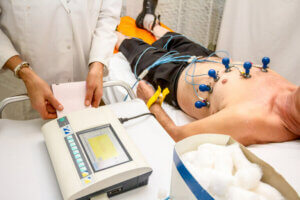What can an Electrocardiogram Detect in an Athlete?

Requesting an ECG for an athlete is a matter of discussion within the medical field. This is especially the case when the electrocardiogram is performed during the initial check-up to detect dangerous conditions before starting to practice a sport. While there’s no debate that athletes with chest-related symptoms should get one, many don’t believe that initial medical examinations should require this test.
It’s safe to assume that this isn’t the case. Doctors are regularly performing electrocardiograms on athletes to assess whether or not they can perform the activity in question. However, not all medical associations agree with prescribing this test massively.
One of the basic elements put into question is the cost-benefit ratio. In other words, some experts have doubts about how useful this test truly is to detect serious problems in relation to the economic cost of performing it on everybody. Whether they’re healthy or sick.
The discussion is even greater when some specialists request other studies, such as a cardiac echo or a cardiac stress test, along with the electrocardiogram. Some specialists propose to limit the initial check-up for athletes to a physical examination and detailed questioning. If cardiological suspicions arise from this, then it’d be necessary to perform an electrocardiogram.
In any case, since the electrocardiogram is a widely spread method, we’ll be discussing its relevance and the things that it can detect in athletes. Since the biggest concern for specialists is sudden death, we’ll start from there.
Young athletes and sudden death: can an electrocardiogram detect it?
When a news story about a young athlete who dies suddenly appears in the media, it can seem as if this is a common occurrence. But this is actually far from true; this condition doesn’t affect athletes any more than it affects the rest of the population.
Sudden death is when the heart stops unexpectedly, without any diseases to explain it. It’s a cardiac arrest that happens out of the blue, in seemingly healthy individuals. There are usually no previous warnings or symptoms.

The idea of performing an electrocardiogram on an athlete is to detect possible coronary complications in time. The problem is that it’s very difficult to interpret the electrocardiogram of a young person that’s actually able to foresee the risk of these complications.
If the athlete had congenital heart disease, the electrocardiogram will most likely detect it. But, if there are no such alterations, and the risk is silent, the test won’t bring it to light.
It’s essential that the ECG doctor performs a detailed physical examination and a complete interview. They must combine complementary tests with other data to establish or discard the presence of a risk.
The most frequent things that an electrocardiogram can detect in athletes
When athletes get an ECG, there are several common findings in the test layout. The specialist must then analyze if those findings are actually normal, which they tend to be.
Sinus bradycardia is common among athletes that train continuously, especially with aerobic exercises. It consists of a below-average heart rate for their age.
A well-trained athlete can make their heart work at 40 beats per minute with no worries; in turn, the general population ranges from 60 to 90 beats per minute. This denotes the athlete’s increased heart efficiency since their heart is able to pump enough blood with less effort.
Another common finding in an athlete’s electrocardiogram is altered cardiac repolarization. This means that the heart muscle relaxes after a contraction. Almost half of all athletes tested showed lines that deviate from the normal standard at this point.

What is normal then?
It’s important to understand that getting results that deviate from the norm in an electrocardiogram doesn’t necessarily mean that there’s a disease. Several sports medicine associations have cataloged a series of findings that they consider to be normal if the person is a well-trained athlete. Some of them are:
- Sinus bradycardia: as we already explained, it’s a heart rate of fewer than 60 beats per minute.
- Negative T wave for young athletes: the T wave of an electrocardiogram is usually positive (it goes up). In athletes under the age of 16, it can be negative without causing any problems.
- Sinus arrhythmia: sudden heart rate changes associated with breathing.
- First-degree Atrioventricular Block (AV Block)
Mandatory electrocardiogram to detect heart risks in athletes
Beyond the scientific discussions about its usefulness, performing an electrocardiogram in athletes has become a legal requirement. In many countries, it’s mandatory to register it when signing up for competitions and even gyms. Therefore, medical professionals must be qualified to interpret and read this complementary testing method.
Requesting an ECG for an athlete is a matter of discussion within the medical field. This is especially the case when the electrocardiogram is performed during the initial check-up to detect dangerous conditions before starting to practice a sport. While there’s no debate that athletes with chest-related symptoms should get one, many don’t believe that initial medical examinations should require this test.
It’s safe to assume that this isn’t the case. Doctors are regularly performing electrocardiograms on athletes to assess whether or not they can perform the activity in question. However, not all medical associations agree with prescribing this test massively.
One of the basic elements put into question is the cost-benefit ratio. In other words, some experts have doubts about how useful this test truly is to detect serious problems in relation to the economic cost of performing it on everybody. Whether they’re healthy or sick.
The discussion is even greater when some specialists request other studies, such as a cardiac echo or a cardiac stress test, along with the electrocardiogram. Some specialists propose to limit the initial check-up for athletes to a physical examination and detailed questioning. If cardiological suspicions arise from this, then it’d be necessary to perform an electrocardiogram.
In any case, since the electrocardiogram is a widely spread method, we’ll be discussing its relevance and the things that it can detect in athletes. Since the biggest concern for specialists is sudden death, we’ll start from there.
Young athletes and sudden death: can an electrocardiogram detect it?
When a news story about a young athlete who dies suddenly appears in the media, it can seem as if this is a common occurrence. But this is actually far from true; this condition doesn’t affect athletes any more than it affects the rest of the population.
Sudden death is when the heart stops unexpectedly, without any diseases to explain it. It’s a cardiac arrest that happens out of the blue, in seemingly healthy individuals. There are usually no previous warnings or symptoms.

The idea of performing an electrocardiogram on an athlete is to detect possible coronary complications in time. The problem is that it’s very difficult to interpret the electrocardiogram of a young person that’s actually able to foresee the risk of these complications.
If the athlete had congenital heart disease, the electrocardiogram will most likely detect it. But, if there are no such alterations, and the risk is silent, the test won’t bring it to light.
It’s essential that the ECG doctor performs a detailed physical examination and a complete interview. They must combine complementary tests with other data to establish or discard the presence of a risk.
The most frequent things that an electrocardiogram can detect in athletes
When athletes get an ECG, there are several common findings in the test layout. The specialist must then analyze if those findings are actually normal, which they tend to be.
Sinus bradycardia is common among athletes that train continuously, especially with aerobic exercises. It consists of a below-average heart rate for their age.
A well-trained athlete can make their heart work at 40 beats per minute with no worries; in turn, the general population ranges from 60 to 90 beats per minute. This denotes the athlete’s increased heart efficiency since their heart is able to pump enough blood with less effort.
Another common finding in an athlete’s electrocardiogram is altered cardiac repolarization. This means that the heart muscle relaxes after a contraction. Almost half of all athletes tested showed lines that deviate from the normal standard at this point.

What is normal then?
It’s important to understand that getting results that deviate from the norm in an electrocardiogram doesn’t necessarily mean that there’s a disease. Several sports medicine associations have cataloged a series of findings that they consider to be normal if the person is a well-trained athlete. Some of them are:
- Sinus bradycardia: as we already explained, it’s a heart rate of fewer than 60 beats per minute.
- Negative T wave for young athletes: the T wave of an electrocardiogram is usually positive (it goes up). In athletes under the age of 16, it can be negative without causing any problems.
- Sinus arrhythmia: sudden heart rate changes associated with breathing.
- First-degree Atrioventricular Block (AV Block)
Mandatory electrocardiogram to detect heart risks in athletes
Beyond the scientific discussions about its usefulness, performing an electrocardiogram in athletes has become a legal requirement. In many countries, it’s mandatory to register it when signing up for competitions and even gyms. Therefore, medical professionals must be qualified to interpret and read this complementary testing method.
All cited sources were thoroughly reviewed by our team to ensure their quality, reliability, currency, and validity. The bibliography of this article was considered reliable and of academic or scientific accuracy.
- Manonelles P, Aguilera B, Boraita A, Luengo E, Pons C, Suárez MP. Utilidad del electrocardiograma de reposo en la prevención de la muerte súbita del deportista. Archivos de Medicina del Deporte. , 119 (2007), pp. 159-68.
- Maron B y col. AHA Science Advisory. Recommendations for Preparticipation screening and the assessment of Cardiovascular Disease in Masters Athletes. Circulation.2001;130:327-334
- Serratosa-Fernández, Luis, et al. Comentarios a los nuevos criterios internacionales para la interpretación del electrocardiograma del deportista. Revista Española de Cardiología 70.11 (2017): 983-990.
- Picarzo, FJ Pérez-Lescure. Guía rápida para la lectura sistemática del ECG pediátrico. Revista Pediatría de Atención Primaria 8.30 (2006): 127-135.
This text is provided for informational purposes only and does not replace consultation with a professional. If in doubt, consult your specialist.








